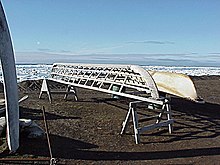Umiak
The umiak, umiaq, umiac, oomiac or oomiak is a type of boat used by Eskimo people, both Yupik and Inuit, and was originally found in all coastal areas from Siberia to Greenland. Its name means "woman's boat," as opposed to the kayak, which means "man's boat".

Like the kayak, the traditional umiak was made from a driftwood frame pegged and lashed together, over which walrus (in western Alaska) or bearded seal skins are stretched. Modern versions are essentially identical with the exception of using metal bolts and screws.
The open umiak is significantly larger than the enclosed kayak which was built to carry one or two men while hunting. A large umiak can hold more than 20 people in its 6 metres (20 ft) to 10 m (33 ft) frame; and about seven skins are needed for the cover on a boat of 30 ft (9.1 m). It has traditionally been used in summer to move people and possessions to seasonal hunting grounds and for hunting whales and walrus.

While the kayak ceased being used in the early 1960s, the umiak skin boat is still very much a part of life in the Yupik and Inupiat Eskimo whaling villages of Alaska. It is still far superior to modern aluminum boats for spring whaling. The boat must be hauled on a sled pulled by snowmobile over very rough trails cut through the ice ridges to locations where there are open leads in the ice pack, where it is used to catch whales.

The skin cover on an umiak will last for two or three years, as does an aluminum boat used in the same way; however, replacing the skin on an umiak is much easier than repairing an aluminum boat. Additionally, Bowhead Whales are sensitive to the metallic noise from aluminum boats, and tend to move away under the ice, to avoid them.

In Barrow, Alaska the process for replacing the skin of an umiak begins when the ice moves away from the shores of the Arctic Ocean in July. At their first summer access to the ocean, whaling crews hunt for oogruk, the Bearded Seal, for suitable skins. The skins are packed into seal oil, and allowed to ferment while they are stored until March. At that time the skins are scraped free of hair, sewn together with a waterproof stitch, and then stretched over the wooden frame and tied into place using the sinew from caribou.

With a new skin on the frame, the umiak is placed out in the wind and cold, to dry. In May when the Bowhead Whales migrate eastward past Point Barrow, umiak skin boats are hauled on sleds pulled by snowmobiles out onto the ice.
See also
External links
- Civilization.ca (images of umiaks)
- Skin boat School
- Crew407
- Alaska Eskimo Whaling Commission
